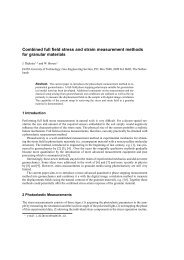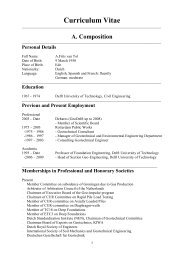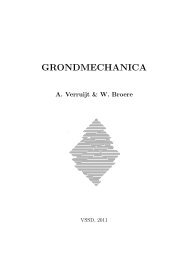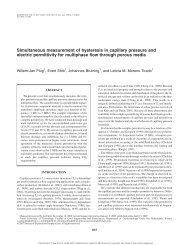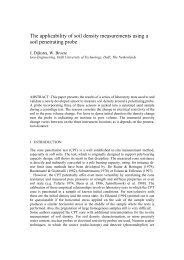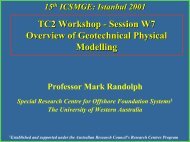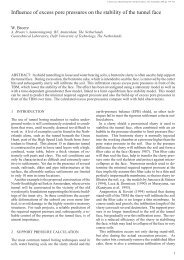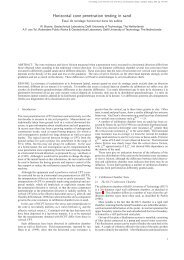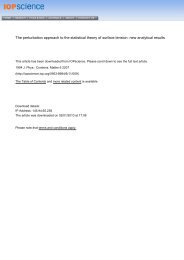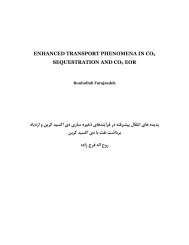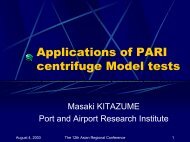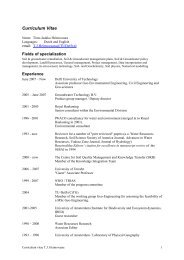Tunnel Face Stability & New CPT Applications - Geo-Engineering
Tunnel Face Stability & New CPT Applications - Geo-Engineering
Tunnel Face Stability & New CPT Applications - Geo-Engineering
You also want an ePaper? Increase the reach of your titles
YUMPU automatically turns print PDFs into web optimized ePapers that Google loves.
150 4. High-Speed Piezocone Tests in Sandsa number of tests has been executed in the DUT calibration chamber on sands at different relativedensities. These tests have been performed using a regular <strong>CPT</strong>U cone and an adapted rig, whichwas able to obtain penetration speeds over 200mm/s, as well as the regular 20mm/s. In orderto determine the excess pore pressures, use was made of the piezometer installed in the cone aswell as separate piezometers installed in the sand bed.The objective of these tests was to determine whether the speed difference between 20 and200mm/s has a detectable influence on the <strong>CPT</strong>U results and whether these differences can beused to determine the liquefaction potential of the sand bed. This last objective should of coursebe seen in relation to the possibilities to determine liquefaction potential from a regular <strong>CPT</strong> or<strong>CPT</strong>U, for example using the method described by Olson (see section 4.2).4.4.1 Equipment and Test MethodFor an overview of the calibration chamber and the preparation method of the sand the reader isreferred to section 3.3. The sand used in this test series was sand No. 2, a uniform fine sand, forwhich the grain size distribution is given in figure 3.6. Minimum and maximum void ratio are0.498 and 0.801 respectively.In contrast to the H<strong>CPT</strong> tests only one sounding was made in each sand sample in this testseries, at position b, see figure 3.13. This was done to eliminate any influence of multiple testsin the same sample on the liquefaction potential and to eliminate any influence of a differentposition with respect to the boundaries of the tank on the dissipation behaviour around thecone. Although performing only a single test per sample eliminates the possible influence of adensification imposed by a previous penetration and the associated change in the liquefactionpotential, it generates a variation between the individual tests due to variations in the preparationof the sand bed.A further difference with the tests described in the previous chapter is that the sand bed waskept fully saturated in these tests. In all tests the water level was adjusted to within 10cm fromthe top of the sand bed, which was the accuracy that could be obtained. From this level thepore pressure was assumed hydrostatic with depth for the interpretation of the test results. Thisleaves, however, an estimated 1kPa variation in the pore pressures between the various tests.These variations in the density of the sample and the water level between the various samplesare the main sources of errors when comparing different tests at similar densities.To measure the excess pore pressures generated by the cone independently from the <strong>CPT</strong>Ucone, two piezometers were installed in the sand bed, at locations approximately 5 and 10cmfrom the projected path of the cone, as sketched in figure 4.6. The pressure transducers usedhad a 70kPa operating range and a reported ±0.1% maximal relative error. Calibration of thetransducers at low stress levels has indeed shown a maximal error slightly less than 70Pa. Thesignals from the piezometers were recorded using a pen recorder.The piezocone used was a 10cm 2 <strong>CPT</strong>U cone, designed by <strong>Geo</strong>mil Equipment bv, withreported measuring ranges and accuracies given in table 4.2. Given the measuring range andaccuracy of the pore pressure transducer, an error up to 8kPa could be expected, especially at lowpore pressures where the effects of non-linearity and hysteresis are most notable. All channelsof the <strong>CPT</strong>U cone were recorded using a <strong>Geo</strong>mil GME400 digital recorder. The combinationof cone and data acquisition system forms a <strong>CPT</strong>U measuring system suited for regular fieldconditions and satisfying the conditions in most (international) soil investigation codes [108].The hydraulic rig used to drive the cones (see figure 4.7) was specially designed by <strong>Geo</strong>mil,based on a standard 100kN rig, but with an adapted hydraulic circuit, including a high capacity



